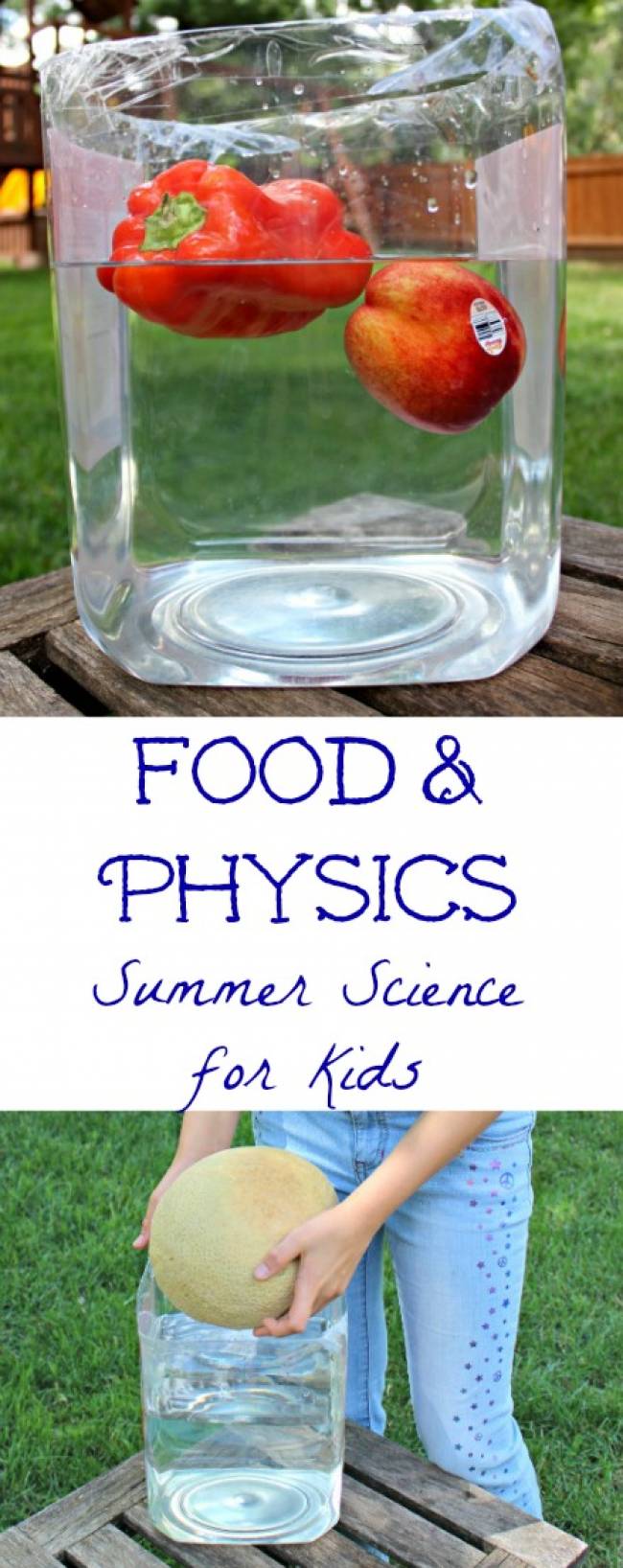Kids will LOVE this easy sink or float science experiment that doubles as a great outdoor activity!
Welcome back to our Summer Science series hosted by Edventures with Kids and Inspiration Laboratories!
So far, we’ve covered —
- biology {books about plants, animals & humans},
- geology {rock, volcano and fossil activities} and
- astronomy {marshmallow constellations}.
This week, we’re focusing on physics and boy, was it hard to narrow down what we wanted to do! There are so many areas of our lives that are governed by the principles of physics — like the fact that we don’t all just float away due to gravity 😉
But we finally decided on a great science experiment that involves water and your favorite fruits — super simple & a great outdoor activity too!
Sink or Float Experiment for Kids
Physics is the area of science that focuses on matter and energy. The areas of mechanics, light, heat, sound, electricity, magnets and forces are all broad areas of physics.
I know — it’s a HUGE part of science and life.
So where do you begin?
With kids, the easiest place to begin is with life experiences.
Talk about the force of gravity when they drop something. Or explore the idea of sound waves and why it’s easier to hear someone talking when they are right next to you vs. when they are in another room.
And I often rely on some good books — because they always bring up great questions! Here’s a few that we really love including their affiliate links that are perfect when discussing physics concepts:
For this specific experiment, there are a few awesome books that help explain the concepts of density, buoyancy and physics:
Things that Float and Things that Don’t – with fun illustrations and a story format, this book helps kids ages 4 – 8 years to understand why some items float and some sink in water. I also love that it introduces how to make predictions too!!
What Floats? What Sinks? is a colorful exploration into these physics concepts! This nonfiction book has gorgeous photographs, clear explanations, a glossary and fun physics activities for kids ages 5 – 9 years old.
We love the Let’s-Read-and-Find-Out Science series! The book Forces Make Things Move is a great look into the various forces that exist around us.
Kids will learn about concepts like gravity and friction in a fun and tangible way. It’s also a great refresher for us parents who haven’t talked about physics since that high school science class 😉
Another one of our favorite science series is the Magic School Bus — both the books and the videos are excellent! The Magic School Bus And The Electric Field Trip explains electricity and electrical currents as kids see what lights up a bulb and how electricity travels to their house.
Older kids can also enjoy exploring science with Ms. Frizzle and the class. Once they outgrow the Magic School Bus picture books, try the chapter book series which shares more details about the various science topics.
A few of the books that cover physics principles include Amazing Magnetism (Magic School Bus Chapter Book #12) and the Electric Storm (Magic School Bus Chapter Books, No. 14)
. These are great for kids ages 8+.
The Classic Sink & Float Experiment: Science Concepts
I can’t believe that I haven’t shared a hands-on sink & float activity yet! This is one of those things that kids do all the time — they LOVE to play with items in water.
First, the physics behind sink & float:
We’ll be testing two physics concepts during this activity.
The first is density — the weight of an item in relation to it’s volume. Volume is how much space something takes up — so Dad has a larger volume than the kids.
The easiest way to explain density is that everything is made up of molecules — the closer together those molecules are, the more dense the item.
Try not to let kids get caught up in saying “if it weighs more, it will sink”.
Something doesn’t need to weigh a lot to sink — for example, give them a really small rock and a really large rock. They will both sink because they are both dense.
The second concept that you can introduce is buoyancy.
Buoyancy is the upward force that supports items in water. This is why we feel lighter when we’re in a pool — there’s actually a force helping to keep us supported and afloat.
I frequently recommend that you try this experiment in the tub while your kids are taking a bath but since we’re dealing with fruit, you might want to use a large pot or bowl instead of the tub (then you’ll be able to eat the fruit later 😉
Sink & Float Experiment: Hands-on Physics for Kids
Ok, time to get wet!
Head to the fridge or your local Farmer’s Market and grab some fruits and veggies — we used a variety of small and large items (it’s just more fun that way). You’ll also need a large bowl or pot filled with water.
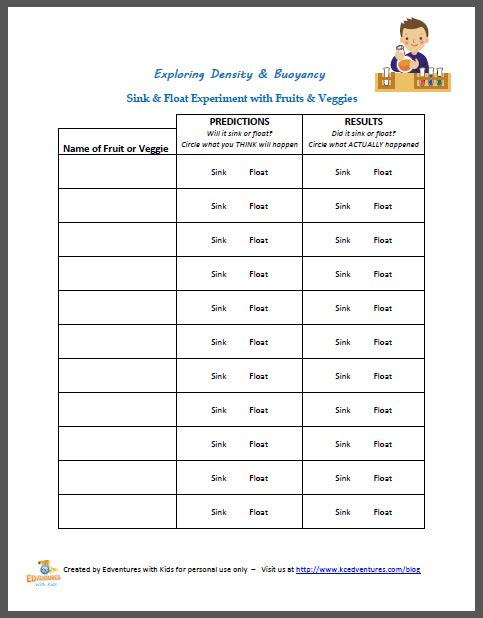
BEFORE you let the kids drop anything in the water, print off our Sink & Float worksheet (below) so kids can make a few predictions about what fruit & veggies will sink or float.
Let the kids hold each of the items you will test. Ask them “Do you think it will sink or float?”
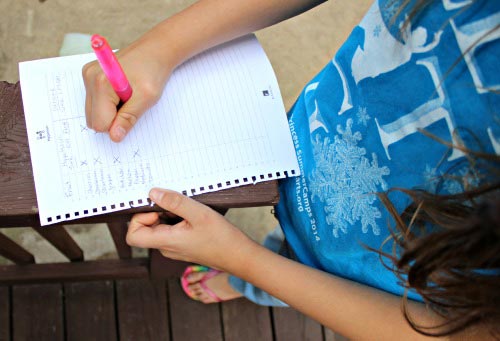
Talk about the idea of density and which items they think are very dense vs. not so dense. Then have the kids circle their prediction for each item.
This is a really important step in any science experiment — forming predictions and testing to see the results!
Now the fun — drop each of the items into the water to see what happens!
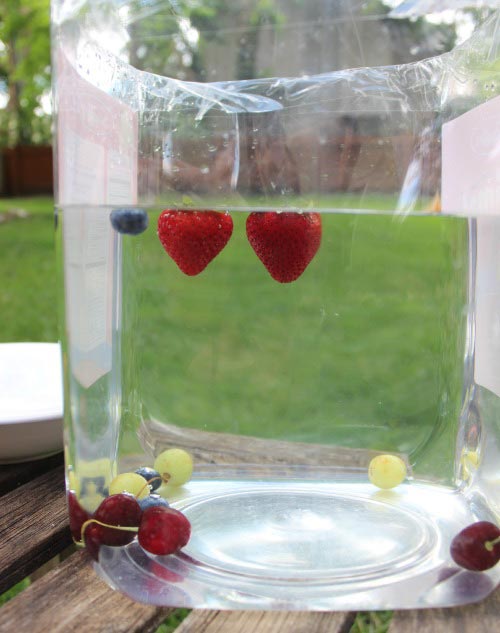
Circle the results for each item — how many did you predict correctly?
We were 50/50 for our small fruit items. My daughter realized that blueberries both sink and float. And strawberries float too! When we cut them open, you can see that the middle (core) of the strawberry is hollow.
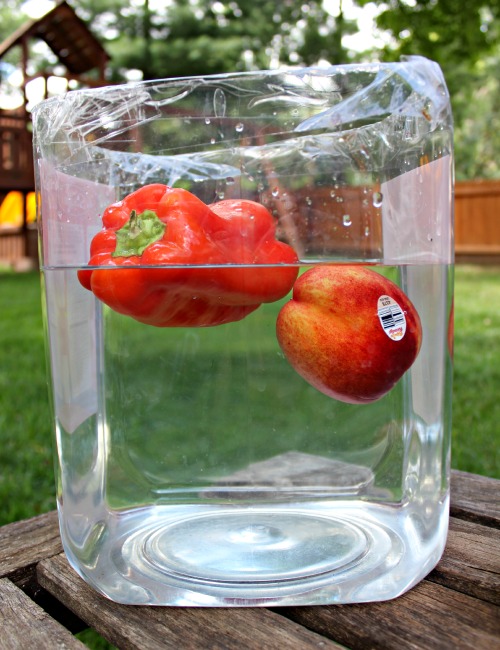
Both peppers and nectarines float! Peppers were an easy guess but necterines took a little thought (the pit being hollow was our learning experience).
Here’s where we can really see buoyancy at play — see how the pepper floats on the top of the water but the nectarine floats below the surface? That shows us how the force of buoyancy affects items differently depending on their density.
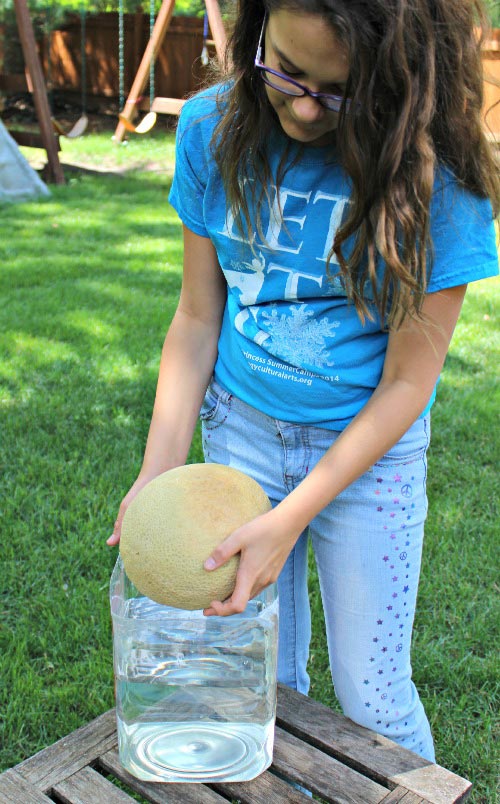
And a melon is one of the coolest things to test (well, that and pumpkins but we don’t have any of those yet).
Melons can be really large compared to the other items and sometimes feel pretty heavy (easy to trick the kids with this one 🙂
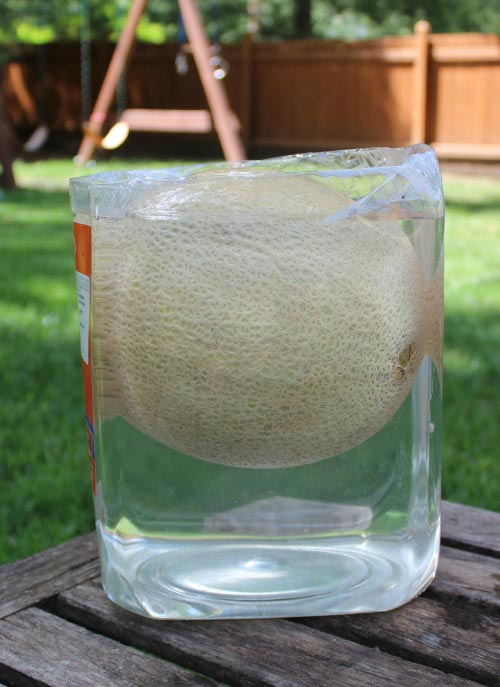
And yep, it floats!
Grab a copy of the Sink & Float worksheet along with some of your favorite fruits & veggies and test out some physics with your kids this week 😉
More Cool Science Experiments for Kids
There are so many ways to discover the different areas of physics! Try a few of these activities including affiliate links to some of our favorite science items:
- If your kids enjoyed this activity, try this STEM Challenge: Building Boats that Float!
- Try easy physics experiments with the Sick Science: 9 Easy Experiments kit
- Hop over and explore color and temperature with Inspiration Laboratories this week.
- Explore all types of physics concepts with the Physics Workshop activity kit!
Be sure to see all of the booklists & activities in our Science for Kids series!

BIOLOGY
Books & Websites that explore Plants, Animals & the Human Body
Backyard Earthworm Experiments
GEOLOGY
The Science of Rocks, Fossils and Volcanoes
Digging for Dinosaurs — Learn to be a Paleontologist
ASTRONOMY
Explore the Night Sky – Marshmallow Constellations
Solar System Activities for Kids
PHYSICS
Fantastic Forces & Water Rockets
CHEMISTRY
Make a Cup Cake (Chemistry of Baking)
Blowing Up Balloons/Blowing Out Candles
ECOLOGY
Kids Activities that Explore Ecology
Create an Under the Sea World: Exploring Ocean Zones

